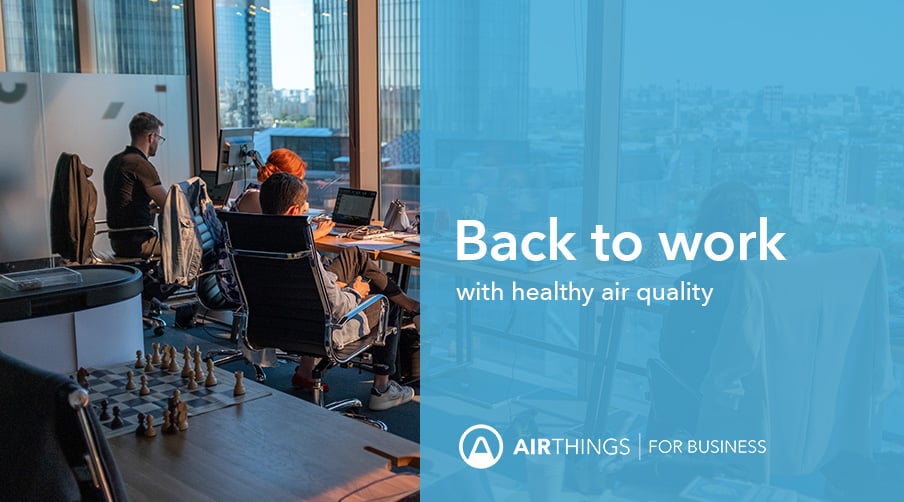Four ways companies can get “back to business” safely by prioritising indoor air quality
If you’re an tenant or office manager and find yourself currently preparing to return your staff to their primary workplace locations, or if you’re an employee preparing to head back into your office, trepidation and hesitance are completely reasonable emotions. These concerns raise a number of questions. What changes to my workflow or the building itself can be made in order to ensure a safe and comfortable operation? Can we quickly and easily implement any new safety measures that won’t hurt our already-tight budget?
Office managers recognize that their employees are their greatest asset, and the utmost care needs to be allocated towards protecting their health and wellbeing.
First and foremost, it needs to be remembered that COVID-19 is an airborne virus that thrives in indoor settings due to close proximity. These factors alone will make it impossible in nearly all cases to resume typical workplace practices as they were pre-pandemic. Following advice from the World Health Organisation and your local government advice is necessary. As a result of COVID-19 an intense focus is now on the health and wellbeing of the workplace. One important factor that all businesses should consider: indoor air quality.

High CO2 means it's time to ventilate
CO₂ levels can vary from room to room. Many of the ventilation systems we use today recycle air to conserve energy, essentially moving contaminated air around rather than bringing in fresh air. This results in high CO2 concentrations and poor indoor air quality.
In an effort to improve ventilation and combat the spread of Covid, many buildings are choosing to install monitors to detect high levels. Bringing fresh air into a room can be as simple as opening a door or window, but it can also be a sign for facility managers that ventilation systems need to be adjusted. By monitoring, you'll know when to act.

Find out about the Airthings for Business CO2 Alert and extensive indoor air quality solutions here→
Sick Building Syndrome
You may have heard the term “Sick Building Syndrome” before. This refers to any indoor space where occupants regularly feel the effects of poor indoor air quality, such as headaches, throat irritation, allergic reactions and difficulty concentrating. While you may think the phrase “Sick Building Syndrome” doesn’t apply to your newly constructed high rise office, the reality is that any building can be “sick” if indoor air quality is not considered.
Understanding what is in the air is the most important first step towards optimizing your building and preventing it, along with your staff, from getting sick. This can only be achieved through decision makers conducting regular monitoring of air quality over time and educating themselves on the pollutants or weak spots that need to be dealt with properly.

Be Honest About Your HVAC
It all starts with the HVAC system. Tenants and office managers can ask their building owner's to assess their current HVAC system to ensure it is functioning properly, cleaned regularly, and circulating in outside air constantly and effectively.
If not, it may be time to invest in a new system or a more efficient way of monitoring indoor pollutants and CO2. This will give you data that indicates if you should increase ventilation, reduce the use of products that emit them or to more regularly replace air filters in your indoor fan systems.
Air quality technology during these times should be viewed as an essential expense - but the best part is that it might not actually be an “expense” at all. Data shows that investing in monitoring will actually create perpetual energy savings for buildings. According to the influential Harvard T.H. Chan School of Public Health study, better air improved decision-making scores by 101%, which translates into a $17,000 productivity boost, per employee, per year1. Extrapolated across a large business, the difference is even more significant.

Virus risk indication
The most common routes of transmission for viruses are via microscopic airborne droplets, larger droplets through sneezing or coughing, and surface contact. Distancing and cleaning habits can help mitigate two of those, but what about the tiny droplets we can’t see? These microscopic droplets can stay viable in the air for long periods of time and travel through a building.
As the situation changes constantly the best thing to do is follow your local government guidelines. Airthings have also created a Virus Risk Indicator. This harnesses the power of four key factors including, virus survival rate, room occupancy, ventilation rate, and the body's natural defences. Get help with identifying risk and set up alerts based on your own chosen thresholds, so you know when action is needed. Learn more about the Airthings for Business Virus Risk here →

Remember 30 to 60%
Last but not least, keep indoor humidity levels to between 30 and 60%. Studies have proven a direct, established link between the facilitation of flu virus , and the low humidity . When humidity levels were at 23%, 70 to 77% of flu virus particles were still able to cause an infection an hour after coughing2. Raising humidity levels to 43% reduced the percentage of infectious particles to just 14%. This threat is compounded with the fact that many office buildings that operate with central air conditioning tend to have exceedingly dry air. At the same time, too high humidity levels can cause excess dampness and mold. Maintaining humidity levels between 30-60% helps prevent both problems.

Source
1. https://dash.harvard.edu/bitstream/handle/1/27662232/4892924.pdf?sequence=1
2. https://journals.plos.org/plosone/article?id=10.1371/journal.pone.0057485
 Most popular
Most popular

 Radon
Radon



 Radon
Radon
 Radon
Radon








